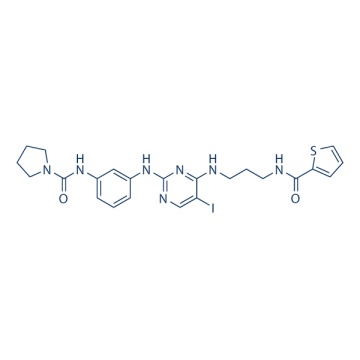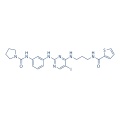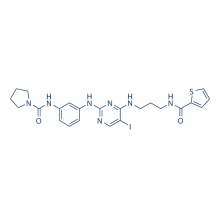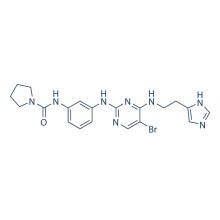.cp_wz tabla {borde superior: 1px sólido #ccc; borde izquierdo: 1px sólido #ccc; } .cp_wz table td {borde derecho: 1px sólido #ccc; borde inferior: 1px sólido #ccc; padding: 5px 0px 0px 5px;} .cp_wz table th {border-right: 1px solid #ccc; border-bottom: 1px solid #ccc; padding: 5px 0px 0px 5px;} \ n Peso molecular: 591.47 BX795 es un inhibidor de PDK1 potente y específico con IC50 de 6 nM, 140 y 1600 veces más selectivo para PDK1 que PKA y PKC, respectivamente. Mientras tanto, en comparación con GSK3β, se observó una selectividad de más de 100 veces para PDK1. \ N BX-795 bloquea eficazmente la actividad de PDK1 en las células PC-3, como se muestra por su capacidad para bloquear la fosforilación de S6K1, Akt, PKCδ y GSK3β. BX-795 inhibe de forma potente el crecimiento de células tumorales en plástico con IC50 de 1,6, 1,4 y 1,9 μM para las células MDA-468, HCT-116 y MiaPaca, respectivamente. En agar blando, BX-795 muestra una mayor inhibición del crecimiento con IC50 de 0,72 y 0,25 μM para las células MDA-468 y PC-3, respectivamente. Además, BX-795, como inhibidor de TBK1 / IKKɛ, bloquea la activación de IRF3 mediada por TBK1 e IKKε y la producción de IFN-β. En las respuestas fisiológicas de las plaquetas, BX795 produce un efecto inhibidor sobre la agregación inducida por 2-MeSADP o por colágeno, la secreción de ATP y la generación de tromboxano. \ n Protocolo (solo como referencia) Ensayo de quinasa: [1]
|
Kinase assays
|
PDK1 is assayed in a direct kinase assay and a coupled assay format measuring PDK1- and PtdIns-3,4-P2-mediated activation of AKT2. For the coupled assay, the final assay mixture (60 μL) contained: 15 mM MOPS, pH 7.2, 1 mg/mL bovine serum albumin, 18 mM β-glycerol phosphate, 0.7 mM dithiothreitol, 3 mM EGTA, 10 mM MgOAc, 7.5 μM ATP, 0.2 μCi of [γ-33P]ATP, 7.5 μM biotinylated peptide substrate (biotin-ARRRDGGGAQPFRPRAATF), 0.5 μL of PtdIns-3,4-P2-containing phospholipid vesicles, 60 pg of purified recombinant human PDK1, and 172 ng of purified recombinant human AKT2. After incubation for 2 h at room temperature, the biotin-labeled peptide is captured from 10 μl of the assay mixture on streptavidin-coated SPA beads, and product formation is measured by scintillation proximity in a Wallac MicroBeta counter. The product formed is proportional to the time of incubation and to the amount of PDK1 and inactive AKT2 added. PDK1 is added at suboptimal levels so that the assay could sensitively detect inhibitors of AKT2 activation as well as direct inhibitors of PDK1 or AKT2. To measure PDK1 activity directly, the final assay mixture (60 μL) contained 50 mM Tris-HCl, pH 7.5, 0.1 mM EGTA, 0.1 mM EDTA, 0.1% β-mercaptoethanol, 1 mg/mL bovine serum albumin, 10 mM MgOAc, 10 μM ATP, 0.2 μCi of [γ-33P]ATP, 7.5 μM substrate peptide (H2N-ARRRGVTTKTFCGT), and 60 ng of purified recombinant human PDK1. After 4 h at room temperature, we add 25 mM EDTA and spotted a portion of the reaction mixture on Whatman P81 phosphocellulose paper. The filter paper is washed three times with 0.75% phosphoric acid and once with acetone. After drying, the filter-bound labeled peptide is quantified using a Fuji phosphorimager.
|
Ensayo celular: [1]
|
Cell lines
|
MDA-468, PC-3, HCT-116 and MiaPaca cells
|
|
Concentrations
|
~10 μM
|
|
Incubation Time
|
72 hours
|
|
Method
|
Cells seeded at a low density (1,500–3,000 cells/well, 0.1 mL/well, 96-well plates) are incubated overnight. Compound treatments are made by adding 10 μL/well of the compound in 1% dimethyl sulfoxide and growth medium (final concentration of dimethyl sulfoxide, 0.1%), followed by brief shaking. Treated cells are incubated for 72 hours, and viability is measured by the addition of 10 μL of the metabolic dye WST-1. The WST-1 signal is read in a plate reader at 450 nm, and a no cell, or zero time cell, background is subtracted to calculate the net signal. Results are reported as the average ± S.E. of two or more replicates.
|
Conversión de diferentes modelos de animales basados en BSA (valor basado en datos del Borrador de Directrices de la FDA)
|
Species
|
Baboon
|
Dog
|
Monkey
|
Rabbit
|
Guinea pig
|
Rat
|
Hamster
|
Mouse
|
|
Weight (kg)
|
12
|
10
|
3
|
1.8
|
0.4
|
0.15
|
0.08
|
0.02
|
|
Body Surface Area (m2)
|
0.6
|
0.5
|
0.24
|
0.15
|
0.05
|
0.025
|
0.02
|
0.007
|
|
Km factor
|
20
|
20
|
12
|
12
|
8
|
6
|
5
|
3
|
|
Animal A (mg/kg) = Animal B (mg/kg) multiplied by
|
Animal B Km
|
|
Animal A Km
|
Por ejemplo, para modificar la dosis de resveratrol utilizada para un ratón (22,4 mg / kg) a una dosis basada en el BSA para una rata, multiplique 22,4 mg / kg por el factor Km para un ratón y luego divida por el factor Km para una rata. Este cálculo da como resultado una dosis equivalente para ratas de resveratrol de 11,2 mg / kg.
|
Rat dose (mg/kg) = mouse dose (22.4 mg/kg) ×
|
mouse Km(3)
|
= 11.2 mg/kg
|
|
rat Km(6)
|
Información química
|
Molecular Weight (MW)
|
591.47
|
|
Formula
|
C23H26IN7O2S
|
|
CAS No.
|
702675-74-9
|
|
Storage
|
3 years -20℃Powder
|
|
6 months-80℃in solvent (DMSO, water, etc.)
|
|
Synonyms
|
|
|
Solubility (25°C) *
|
In vitro
|
DMSO
|
100 mg/mL
(169.07 mM)
|
|
Water
|
<1 mg/mL
(
|
|
Ethanol
|
<1 mg/mL
(
|
|
In vivo
|
30% PEG400/0.5% Tween80/5% propylene glycol
|
30 mg/mL
|
* <1 mg/ml means slightly soluble or insoluble.
* Please note that Selleck tests the solubility of all compounds in-house, and the actual solubility may differ slightly from published values. This is normal and is due to slight batch-to-batch variations.
|
|
Chemical Name
|
N-(3-(5-iodo-4-(3-(thiophene-2-carboxamido)propylamino)pyrimidin-2-ylamino)phenyl)pyrrolidine-1-carboxamide
|
Calculadora de molaridad Calculadora de dilución Calculadora de peso molecular
Grupos de Producto : PI3K / Akt / mTOR > Inhibidor de PDK-1








